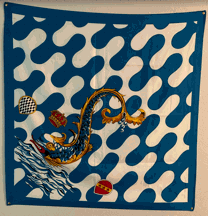 images from Noah Jacoby,
20 May 2022
images from Noah Jacoby,
20 May 2022
FOTW beschäftigt sich mit der Wissenschaft der Vexillologie (Flaggenkunde).
Alle auf dieser Website dargebotenen Abbildungen dienen ausschließlich der Informationsvermittlung im Sinne der Flaggenkunde.
Wir distanziert uns ausdrücklich von allen hierauf dargestellten Symbolen verfassungsfeindlicher Organisationen.
Last modified: 2022-06-25 by rob raeside
Keywords: italy | siena | palio | tuscany |
Links: FOTW homepage |
search |
disclaimer and copyright |
write us |
mirrors
See also:
I got Siena Palio images from a postcard series copyright ca.
1955. The flags from the postcards are the main standards of the
contrade (districts). These are not the throwing versions,
which appear to be much less elaborate. There is also some
evidence that there is no fixed pattern for these flags, and that
they may evolve with the fashions of the times.
T.F. Mills 24 July 1999
This is the most complete site about Palio, Contrade....many
images and flags at <www.ilpaliodisiena.com>.
Alex Baldi , Le Muse Multimediali , 28 March 2000
There are 17 family-districts (contrade) in Siena. You can see their
flags at
http://www.comune.siena.it/La-Citta/Palio/Siena-e-il-Palio/Il-Drappellone.
T.F. Mills, 14 November 2000 and Ole Andersen,
23 March 2001
Having seen many images of the Palio over the decades, I think
it is safe to say there is no "sealed pattern" for
these flags, and they follow the ancient custom of "heraldic
license" where details are not prescribed.
There is also a big difference between these large flags carried
by the standard bearer of each contrada, and the smaller throwing
flags. The latter tend to be of much simpler design, and
they also seem to vary over the years. The constants would
appear to be the major colours and the principal motif.
T.F. Mills, 23 March 2001
I was asked by Jorge Candeias: is there an adequate
translation in English of "contrada"?
I checked this out yesterday and my dictionary reports
'district', even though it suggests using 'contrada' when
relating to those of Siena. To the best of my knowledge, Palio
roughly translates as 'tournament'. I think the reason is that
much of the fame of Siena is from those 'contrade', as much as
Venice to canals, which are usually translated like that and not
like 'channels' or 'rivers', even though they are actually such
things.
Manuel Giorgini, 14 November 2001
The "contrade" are the quarters of the city that try
to win a flag (il palio) on July 2nd for the first time and on 15
August 15th, for the second time. The race is an horse race on
the main place of the city. Is a medieval race with the people
dressed with medieval costumes. If you want it's possible to have
more information in the site of the town <www.comune.siena.it>.
Bruno Fracasso, 18 December 2001
Mills says that "[...] There is also some evidence that
there is no fixed pattern for these flags, and that they may
evolve with the fashions of the times.[...]". Now this is
not more true because the Consorzio per la Tutela del Palio di
Siena has internationally registered the Marks and flags of each
Contrada. So there is a difference between ORIGINAL Palio di
Siena flags and IMITATIONS: for every information and images
these two links are official: <www.ctps.it>
(click on ENTRA, then on "AREA MACRCHIO" then on
"I Marchi Registrati" you will have all the ORIGINAL
and OFFICIAL 17 Contradas registered Marks of flags).
Contrada has not a real english translation, you can compare to a
district (that in italian we say QUARTIERE), but it has not a
translation, the Consorzio per la Tutela del Palio di Siena uses
it also in English: singular: CONTRADA, plurial: CONTRADAS. Also
in Italy the name Contrada is unique for those cities that have a
Palio (there are hundreds of Palio in Italy, above all in the
Centre, like Ascoli, etc.). The district in fact is a concept
relating to the urbanization, normally you divide cities in
different district with different services accesses; while if you
take a look of Contrada division it has nothing relating to the
city shape or services, it has an historical and familiar origin.
Consider that in the 1200 there were about 50 different Contrada
in Siena.
Actually biggest images of Palio di Siena are on our website <www.flagsonline.it>
(Click on each contrada to enlarge the image).
Paolo. 11 May 2005
The "contrada" (plural "contrade") is one
of the 17 (currently and since 18th century) inner city districts
(just within the ancient walls). In (fairly old-fashioned)
Italian it's the equivalent of "piece of land". Their
origin is not absolutely certain but the most acknowledge
interpretation is that they derive from medieval
"confraternite", i.e. private associations of citizens
dedicated mainly to social scopes like assisting orphans or
widows or homeless, etc. Those associations
"overlapped" with the military organization of the
city, where each district had the responsibility to ward a
section of the walls or provide a certain amount and type of
armed men. By the way, do not look at a map of Siena trying to
understand the relationship between the apparent shape of a
contrada territory and other functions, as the city territory is
so complicated by steep up and downs that a "flat" map
will never correctly represent it.
The name "palio" (plural "palii") comes from
the Latin "pallium" which means "broad piece of
precious cloth" and refers to the prize (a long, broad piece
of precious cloth) which was awarded to the contrada winning
ancient contests. Those contests were not originally horse races,
they were "shows" or "processions" made in
honour of a saint or of an illustrious person visiting Siena. The
contrada performing the best show was awarded the
"pallium".
The Palio of Siena is NOT a medieval revocation, it's the REAL
thing! In fact, the Palio in Siena NEVER went "out of
fashion" during the centuries (differently from all other
palii which have been resumed for touristic reasons).
Finally, about the flags. There's now fixed shape or design for
the flags of the contrade. Only the colours and the symbol are
fixed. Contrade periodically "refresh" their flags with
a new design. The Consorzio di Tutela del Palio is an
almost-commercial institution, barely recognized by true senese
people. Any flag you could just buy in Siena is, by definition,
NOT an original one, as flags are considered sacred by the people
and they would NEVER sell the TRUE flags. In recent years, some
tourists have stolen flags from the house fronts, maybe thinking
they were just nicking an "advertising gadget". Please
consider that this is, to Siena people, like stealing a sacred ornament in a
church!
Carlo Duroni, 25 May 2006
Three older flags (photos 1,
2, 3) of Sienese contrade
(approx. 1957) are for sale at the Italian
Ebay.
M. Schmöger, 8 June 2006
Several historical postcards were on sale at Italian Ebay, all of them showing
variants of the respective Siena contrade flags: Selva. Tartuca and Pantera. A more modern
(1963?) postcard as well.
M. Schmöger, 1 November 2006
Currently at the Italian Ebay
there several flags of the contrade of Siena such as here
and here.
M. Schmöger, 12 July 2007
As I understand it, they have at least the following flags:
As an example:
Peter Hans van den Muijzenberg, 17 July 2016
I found the coat of arms evolution (from 1546 to 1888) here:
http://www.ilpalio.org/veaqu.gif,
source:
http://www.ilpalio.org/veaqu.htm). And they have in fact a film archive of
several contests of the different contrade:
http://www.ilpalio.org/playlist.htm. Here also is another collection of
flags (copyright Immagini ©Giuseppe Pirastru) through time (source:
http://www.sienafree.it/palio-e-contrade/aquila/41569-le-contrade-di-siena-raccontate-dai-priori-aquila-fotogallery):
-
http://www.sienafree.it/images/palio/contrade/aquila/priori-aquila-fotogallery/DSC_9645.JPG
-
http://www.sienafree.it/images/palio/contrade/aquila/priori-aquila-fotogallery/DSC_9648.JPG
-
http://www.sienafree.it/images/palio/contrade/aquila/priori-aquila-fotogallery/DSC_9649.JPG
-
http://www.sienafree.it/images/palio/contrade/aquila/priori-aquila-fotogallery/DSC_9653.JPG
-
http://www.sienafree.it/images/palio/contrade/aquila/priori-aquila-fotogallery/DSC_9657.JPG
-
http://www.sienafree.it/images/palio/contrade/aquila/priori-aquila-fotogallery/DSC_9661.JPG
There is an entry on Aquila:
http://www.sienafree.it/palio-e-contrade/aquila and also the main site with
all of them:
http://www.sienafree.it/palio-e-contrade. Also on their official website, an
entry on the museum contains several flags as well:
http://www.contradadellaquila.com/contrada/sede-e-museo.
Esteban
Rivera, 18 July 2016
These festival flags keep appearing with new variants appearing each year for
the celebrations.
Pete Loeser, 23 May 2022
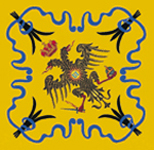 image by
Bruno Fracasso, 18 December 2001
image by
Bruno Fracasso, 18 December 2001That's what the flag looked like on 1 July
2011, according to http://www.panoramio.com/photo/55054084, and still does
according to
http://meerdanvijftig.nl/middeleeuws-siena-nog-springlevend.
If my theory is correct, then the design of the tourist flags would probably
have had the shields somewhere. The banner, in 2012 looked like this:
https://www.flickr.com/photos/iltesorodisiena/8085930857, it seems,
assuming that that's the right way to describe it.
Peter Hans van den Muijzenberg, 18 July 2016
Also, please see
this other flag, source:
https://it.wikipedia.org/wiki/Nobile_Contrada_dell%27Aquila of the "Nobile
Contrada dell'Aquila" (official name) (official website:
http://www.contradadellaquila.com).
Esteban Rivera,, 18 July 2016
I think that's a slightly older style.
With all of the Internet available the problem isn't as much to find different
styles, but more to correctly determine dates and purposes. In my recollection
this one used to be quite prominent, though, suggesting that it may have been
the last previous style.
Peter Hans van den Muijzenberg, 18 July 2016
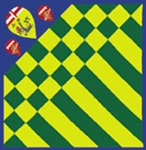 image by
Bruno Fracasso, 18 December 2001
image by
Bruno Fracasso, 18 December 2001
 image by
Bruno Fracasso, 18 December 2001
image by
Bruno Fracasso, 18 December 2001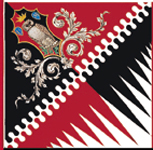 image by
Bruno Fracasso, 18 December 2001
image by
Bruno Fracasso, 18 December 2001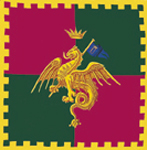 image by
Bruno Fracasso, 18 December 2001
image by
Bruno Fracasso, 18 December 2001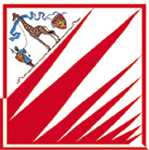 image by
Bruno Fracasso, 18 December 2001
image by
Bruno Fracasso, 18 December 2001 image by
Bruno Fracasso, 18 December 2001
image by
Bruno Fracasso, 18 December 2001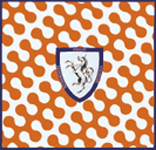 image by
Bruno Fracasso, 18 December 2001
image by
Bruno Fracasso, 18 December 2001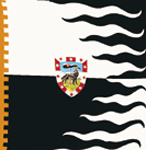 image by
Bruno Fracasso, 18 December 2001
image by
Bruno Fracasso, 18 December 2001
The flag of the
Contrada della Lupa, winner of the first leg, because there are two events:
one in July and one in August, of the Palio di Siena was posted by Gianluca
Lentini on FOTW-fb.
Esteban Rivera, 25 July 2016
According to legend, the city of Siena was named after Senio/Senius, son of
Remus. Senio and his brother Aschio fled north after Romulus killed their
father. They brought with them a carving of the one who raised their father and
his brother: a she-wolf. Eventually they founded a city of their own, Siena,
where the she-wolf became the city symbol. White and black eventually became the
city's colours, flag and arms.
The Contrada della Lupa (ward of the
she-wolf), stretches to the north from the Piazza del Campo where the Palio of
Siena is held. The main charge of Lupa's arms is the symbol of the city: The
she-wolf suckling two boys. Its colours are white and black, but they differ
from the city's colours in that Lupa always has an orange lining. After 27
years, the Contrada della Lupa won the Palio of 2 July 2016. (And even then, in
1989 the race was won by a riderless horse; the last time Lupa saw their jockey
win was in 1973.)
Peter Hans van den Muijzenberg, 26 July 2016
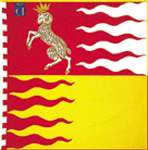 image by
Bruno Fracasso, 18 December 2001
image by
Bruno Fracasso, 18 December 2001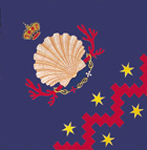 image by
Bruno Fracasso, 18 December 2001
image by
Bruno Fracasso, 18 December 2001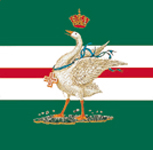 image by
Bruno Fracasso, 18 December 2001
image by
Bruno Fracasso, 18 December 2001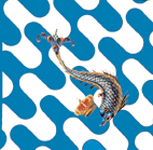 image by
Bruno Fracasso, 18 December 2001
image by
Bruno Fracasso, 18 December 2001
 images from Noah Jacoby,
20 May 2022
images from Noah Jacoby,
20 May 2022
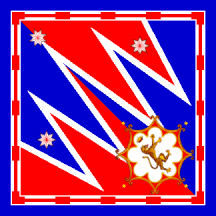 image by M. Schmöger, 23 August 2001
image by M. Schmöger, 23 August 2001
detail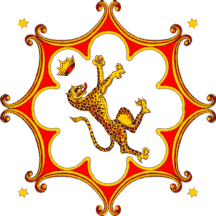 image by M. Schmöger, 23 August 2001
image by M. Schmöger, 23 August 2001
Recently a friend of mine brought me a flag he bought in
Siena. It is obviously one of the flags of the Contrade in Siena,
namely the Contrade della Pantera. It differs from the design
shown on the website of Siena, though.
However, there were already reports, that there are always quite
a lot of variations from the basic design.
M. Schmöger, 23 August 2001
The Contrada della Pantera flag is not correct: as you can
verify on the official Contrada website: <www.contradadellapantera.it>
the Coat of Arms is in the upper-left corner, the image Moreover
the pantheress is not correct: crown is closer. Finally also the
flag background is not correct. Also in the Comune di Siena <www.comune.siena.it>
you have the real flag and not this one.
Paolo.
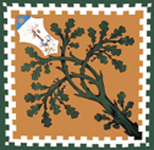 image by
Bruno Fracasso, 18 December 2001
image by
Bruno Fracasso, 18 December 2001
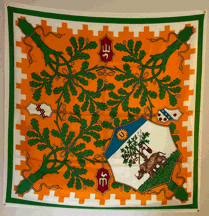 images from Noah Jacoby,
20 May 2022
images from Noah Jacoby,
20 May 2022
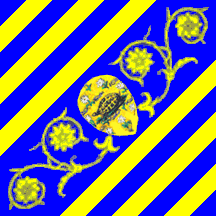 image by António Martins-Tuválkin, 27 March 2005
image by António Martins-Tuválkin, 27 March 2005
The Contrada della Tartuca (Turtle District) palio
flag - As all the others, it is square, with diagonal ascending
stripes (from bottom hoist to top fly) in blue and yellow. The
middle stripe (a blue one) is about five times wider and shows
the district Coat of Arms shield flanked by symmetrical flower
branch ornaments; the other stripes are six to each side (the
last ones, also blue, show as triangles, at top hoist and bottom
fly). The Coat of Arms is a turtle proper on a ground or
semeé of daisies proper.
António Martins-Tuválkin, 27 March 2005
This image is not the original Tartuca flag but it is a flag
sold as Tartuca contrada. The original Tartuca image is at <www.ctps.it>.
Differences are in colours and designs (shapes), for example
Tartuca you sent has a completely different turtle: the original
is a green turtle, quite spherical, with the head looking above.
Turtle you sent was completely different. Also turtle background
is quite different "Margherita" (white flowers name in
Italian) in this image are enormous, original one shows flowers
really different.
Paolo, 29 March and 4 April 2005
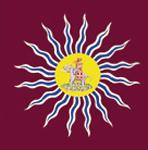 image by
Bruno Fracasso, 18 December 2001
image by
Bruno Fracasso, 18 December 2001
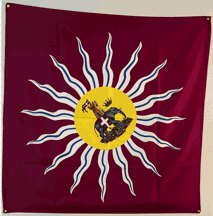 images from Noah Jacoby,
20 May 2022
images from Noah Jacoby,
20 May 2022
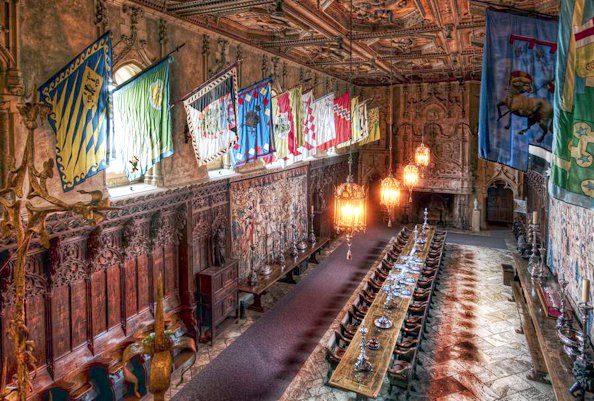
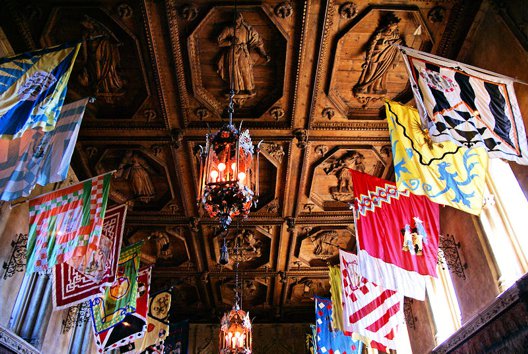 images from Bishop Lamoureux, 15 April 2015
images from Bishop Lamoureux, 15 April 2015In Hearst Castle, a historical landmark and state park located on the Central Coast of California is a collection of flags hanging over the dining room. Bishop Lamoureux, 15 April 2015
These are Siena Ward flags. Or rather, they are replicas of the original
banners that are part of Hearst's collection. I expect none of these medieval
banners will match the current ones. The banners seem to change over time, plus
through the years quite a number of wards have disappeared. (There would even be
some logic in these specifically being banners of wards that no longer exist.)
Peter Hans van den Muijzenberg, 15 April 2015
It seems commonplace for these Palio flags to be displayed indoors in several places around the world. For the full list of Contrade, please see Contrade of Siena and also note the pictures captioned "Flag of Onda contrada hanging in the cathedral of Siena" and "Flag of Onda contrada hanging in the cathedral of Siena" on the same page. It is interesting to point out is that "Palio"
in Italian means "Standard" (as derived from the word "stick", thus, having a
banner hanging from a stick or pole).
Sources: Palio di Siena and the Official Siena Website.
Esteban Rivera, 15 April 2015
I've already posted the short identification that these are Siena ward flags. (Well, they are replica's, but the originals are supposed to indeed be in Hearst's collection.) It took a while to gather recognisable
images of most of the flags, though.
Counter to my original understanding, these don't seem to be really ancient flags, possibly from no longer existing wards. Rather, most may have been flags from a few years prior to the time Hearst acquired them.
On the wall to the left of the camera in the first image are:
- Tartuca ward
- Bruco ward
- Lupa ward
- Nicchio ward
- Drago ward
- Giraffa ward
- Onda ward
- Torre ward
- Aquila ward
- Lupa ward
- Bruco ward
All of those are indeed visible in the first image. The second image is in the other direction, showing the flags from the last to the first, with Bruco ward not in view, above or behind the camera, and the far Lupa ward flag obscured by the Nicchio ward flag in front of it.
On the wall to the right of the camera in this image are:
- Bruco ward
- The Lamb of God.
- Lupa ward
- Aquila ward
- Civetta ward
- Bruco ward
- Giraffa ward
- Selva ward
- Onda ward
- Tartuca ward
- Oca ward
- I-don't-know-which ward
In the first image, only the first two are plainly visible. Because of the shape of the banner showing the Lamb of God, a part of the Lupa ward flag is visible underneath it. Also, as it's also a rather fine material, a bit of the Aquila ward flag is just visible though the material.
The second image is in the other direction, and shows the flags from the last to the first, except that the Tartuca ward flag is the first visible one, with the two before it being above or behind the camera, and the Bruco ward flag is obscured by the larger Lamb of God banner in front of it.
Several wards make more than one appearance in these two lists. This is correct, as they are indeed present with several flags. Each flag is of a different design, though. What remains the same are the colours and the arms, which are the features that identify the ward. Curiously,
in approximately 2012 the order in the second list seems to have changed, in that the two Bruco ward flags switched places, as did the Selva ward and Oca ward flags. As
the second image (and therefore the matching first image is apparently older than that, see web archive of dining room photo), the flags are no longer exactly in the order shown in the photographs and given in the list above.
I don't think the banner showing the Lamb of God is a ward flag. It appears to be different in shape, in material, in style and in imagery. If it really has to belong to a ward, it would fit somewhat with Valdimontone ward, but it would mean they have completely changed their style since then. I don't think that is it.
The I-don't-know-which ward flag took me the longest, as it's in the corner on the side away from the main entry and the balcony, thus it's almost always obscured or above or behind the camera. When I finally found a photograph showing it, I found it really looks like just another ward flag, but it has no central charge. It just has shields at the top and bottom corner. Well, maybe with an even better photograph, showing the obverse to be sure, I might recall where I saw those particular shields before. For now, if I would have to hazard a guess, I'd give it to Bruco ward, but please ask all relatives who mention Hearst Castle if they can take a good photograph of this one.
That's as far as I can bring it. Please, contact any connections you have with Hearst Castle or Siena, but for now these last two remain unidentified, with a very small amount of speculation.
Peter Hans van den Muijzenberg, 18 August 2015
Hosted by: Fanshop-Online.de und Handy-Shop.de
Tipp: Apple iPhone 13 im Shop